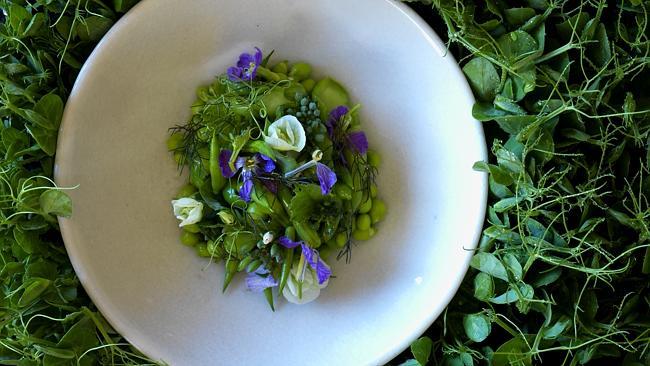Biota Dining, Bowral: chef James Viles inspired by local ingredients
Chef James Viles tasted success and found it wanting. Inspiration struck when he returned home to Bowral, NSW.

The culinary epiphany that changed James Viles’s life occurred 50 floors up, in a 500-room hotel in Dubai. It was around 2010, and the young chef de cuisine, in charge of an army of chefs cooking with produce flown to the desert from all over the world, was wondering: how far from nature can you get? What does it all mean on the plate? How can we reconnect?
Viles had tasted “success” and found it wanting. Returning home to the NSW Southern Highlands, he looked around ... and found his inspiration.
Along the waterways there was wild mint; the blackberries he picked by the kilo as a boy still rambled by the railway. Depending on the season, there’d be “watercress, dandelion, mallow, native raspberries, riberries, lavender ... so many different wild plants, introduced and native”. There were wild mushrooms, deer, ducks and trout. Not to mention meat and dairy from the local farms. If you were looking for an ecology that could support a restaurant based on farmed, fished and foraged produce, why look further?
Viles and his father went into partnership and in 2011, Biota Dining opened in Bowral. Awarded a place among this newspaper’s Hot 50 Restaurants this year, it goes from strength to strength.
“The mission is to showcase ingredients that are in the region at certain times of the year,” says Viles, 36. “When they’re not, they’re not on the menu.
“You don’t need to import ingredients from everywhere when we have all these things on the doorstep. We just need to be a bit creative and resourceful.”
The cookbook Biota, full of stories about the local riches and producers, showcases this creativity in stunning pictures. Many of the seasonally grouped recipes, with their multiple parts and all-natural ingredients (explained in an extensive glossary: samphire or iota carrageenan, anyone?) might be a bit daunting for home cooks, I venture.
Viles suggests starting with the simple recipes at the front of the book (think sorbet base, pine oil, salted plums: basics that can be kept). As for the bigger dishes, we’re encouraged to mix, match or substitute the fresh elements depending on season and resources. “That’s what cooking is about,” he says. “It’s about adaptation.”
Legumes, their flowers, and fresh cheese
Serves 4
Fresh milk is something we tend to take for granted but it is quite special, especially when pure and free from human intervention. Sometimes the simplest things are the best. If you can use unpasteurised milk from a local farm here, then do so; if not, use the most lightly pasteurised milk you can find. Milk that has had the least amount of human interference will make a better cheese and have a finer texture and flavour.
Fresh cheese
400ml full-fat cow’s milk
2g rennet *
1 tsp salt
Put the milk in a heavy-based saucepan and heat to 32C. Remove from the heat and stir in the rennet. Pour the mixture into four 100ml dariole moulds or plastic containers, filling to about 1cm from the top. Put the moulds in a baking tray and fill the tray with warm water. Cook the cheese in a very low oven for two hours, keeping the water at 38C. Remove from the oven and leave to cool in the tray. Line a perforated tray with muslin (cheesecloth) and gently tip the cheeses out of the moulds on to the lined tray. Put this over another tray to catch the whey, and leave the cheeses in the fridge for two hours to dry out. Keep the whey for the dressing.
Fresh whey dressing
150ml whey from the fresh cheese
30ml olive oil
2 tsp salt
Combine the fresh whey with the olive oil and salt and whisk until the dressing is emulsified.
Legumes
150g fresh broad beans
160g podded fresh sugar snap peas
20 radish pods *
20ml linseed (flaxseed) oil
Juice of 1 lemon
1 tsp salt
Double-pod the broad beans. When ready to plate, combine the raw vegetables and mix with the oil, lemon juice and salt.
Shoots on the plate
1 punnet pea shoots
1 punnet mung bean shoots
20 new pea blossoms
20 radish flowers
* Rennet is a complex mixture of enzymes produced in the stomachs of ruminant mammals and used in the production of most cheeses. From good ingredient shops.
* Radish pods form after the plant goes to seed. The best variety for this is the rat-tail radish. These have a strong flavour and can be eaten blanched and chilled or raw when young. If you can’t source radish pods you could use the stem of the rape plant, or just the radish itself.

To join the conversation, please log in. Don't have an account? Register
Join the conversation, you are commenting as Logout